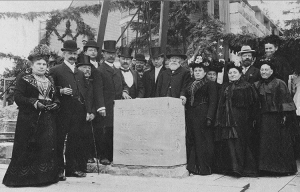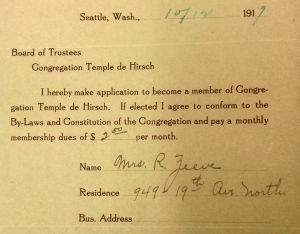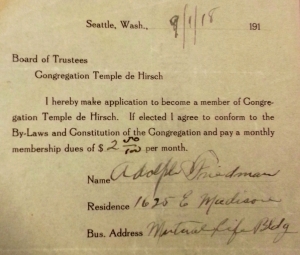Assuming Progress: Analyzing Documents from Temple De Hirsch

 As you can see, no explicit allusion is made to sex whatsoever. This constitution from 1900 doesn’t definitively tell us weather women were members or not. There are two possible explanations for the absence of women in this document: either it was assumed that readers would understand women were NOT allowed to become members, or assumed that readers would understand that women WERE able to join the congregation.
As you can see, no explicit allusion is made to sex whatsoever. This constitution from 1900 doesn’t definitively tell us weather women were members or not. There are two possible explanations for the absence of women in this document: either it was assumed that readers would understand women were NOT allowed to become members, or assumed that readers would understand that women WERE able to join the congregation.
This picture from the cornerstone laying of De Hirsch in 1901 prominently features women, suggesting that, members or not, women were active and involved in pivotal events of the synagogue. The lack of segregation between sexes and the prominent positions of the women in the photo further suggest that women may have enjoyed equality within the congregation. Washington State granted women suffrage rights relatively early (in 1854), and as such, the constitution of De Hirsch was written in an environment where women did have equal voting rights. These facts lead me to believe that the assumption would have been that women WOULD have full membership in the congregation. However, I must note that I cannot prove this and that the true assumptions inherent in the first constitution of De Hirsch are yet unclear. While we have no concrete evidence as to whether women were counted as full congregants at De Hirsch in 1900 (the time of the first constitution and the above photo), we can definitively state that by 1919, approximately the date of the constitution from BCMH that we have already examined, women could indeed become full members.
The above slips are membership requests for De Hirsch dating back to 1919. As you can see, there is no difference in the applications for male and female members, and the dues paid by our subjects (Adolph Friedman and Mrs. R Jeeve) are identical. From the lack of differentiation of women in the early constitution, the prominence of women in pictures and print sources, and from identical membership application slips and dues, we can thus authoritatively say that by 1919 women were allowed full participation in the congregation at Temple De Hirsch. Amidst a time fraught with national debate surrounding womens suffrage, this was actually a bold stance towards gender equality. De Hirsch even went farther than the permissive attitudes of BCMH, refusing to differentiate prospective members by sex altogether. Other documents corroborate this story: A document from 1915 detailing membership in the congregation doesn’t distinguish based on sex, but rather on the amount of dues members pay.


